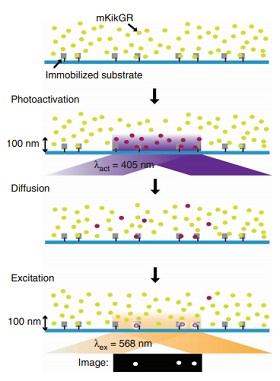Using AI to control energy for indoor agriculture
30 September 2024
Published online 14 September 2012

Imaging single fluorescently labelled macromolecules can reveal details about their activity that other experiments simply cannot. However, at physiological concentrations, background fluorescence often overwhelms the signal from individual molecules.
A team of scientists from Harvard University, including Satoshi Habuchi, now at King Abdullah University of Science and Technology (KAUST) in Saudi Arabia, have developed a new technique PhADE (PhotoActivation, Diffusion and Excitation) that overcomes the problem of background fluorescence.
A protein of interest is tagged with a type of fluorescent protein that can change its emission characteristics when hit by a pulse of a specific wavelength of light. The protein is then added to a binding substrate that has been immobilized in a microfluidic flow cell. After photoactivation of a fraction of the fluorescent protein near the surface, rapid diffusion eliminates any unbound protein that could cause background fluorescence, leaving only the molecules that formed bonds with the substrate. These individual molecular interactions can then be visualised upon fluorescent excitation.
The researchers used PhADE to investigate the dynamics of DNA replication. Imaging individual molecules of Fen1, an enzyme involved in joining fragments of DNA together, interacting with immobilized DNA, they were able to measure the rate at which replication proceeds, the frequency of replication initiation, and the half-life of Fen1.
The authors stress the broad potential applications of PhADE, as it can conceivably be used for scrutinizing any protein with a wide range of possible fluorophores. "We hope that PhADE will become a widely used method to study the dynamics of complex biochemical reactions, particularly in cases where there is a weak but important protein-protein or protein-nucleic acid interaction that cannot be imaged with conventional single molecule tools," says Johannes Walter, one of the studies' senior authors.
doi:10.1038/nmiddleeast.2012.132
Stay connected: